Let's look at the structure of the carrot root system - what are its features?
Carrots are an unpretentious crop, but sometimes when growing them, gardeners are faced with the fact that the root crops are of non-standard shape or color. To prevent this, it is important to know the structural features of the root system and the conditions favorable for the development of the vegetable.
Botanical description of carrots
Carrots are a biennial cross-pollinated herbaceous plant of the Apiaceae family. In the first year after planting, farmers receive a harvest, in the second they collect seeds. Flowering in the first year of life is due to violation of the rules of agricultural technology. In this case, the plant will not produce root crops.
Inflorescences They are complex umbrellas consisting of rays of different lengths. During the flowering period they are convex or flat, later - compressed. The flowers are bisexual, small, white, pink or pale purple.
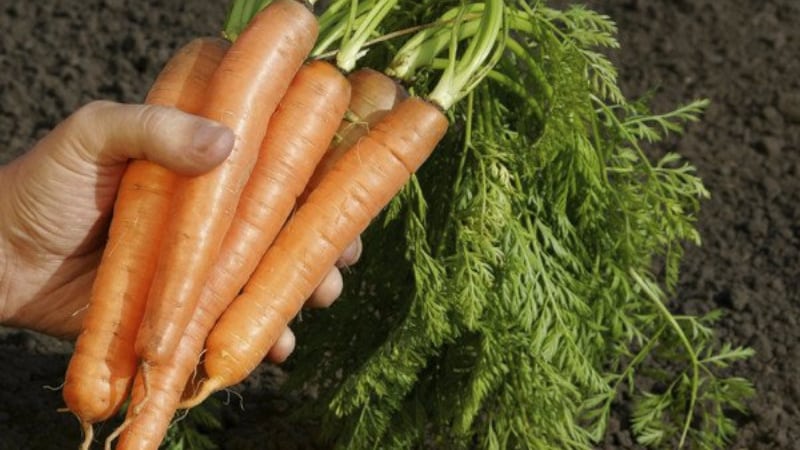
The fruits are two-seeded, oblong, with two rows of sharp bristles. Their different quality is the main reason for the uneven germination and development of plants. The best seeds form on the central umbels and are collected in August.
Important! The fruit shells contain essential oil, which quickly deteriorates, which is why the seed when stored for more than 2 years gives poor germination. Oil prevents moisture from reaching the embryo, which delays its swelling and germination.
Characteristics of the root system
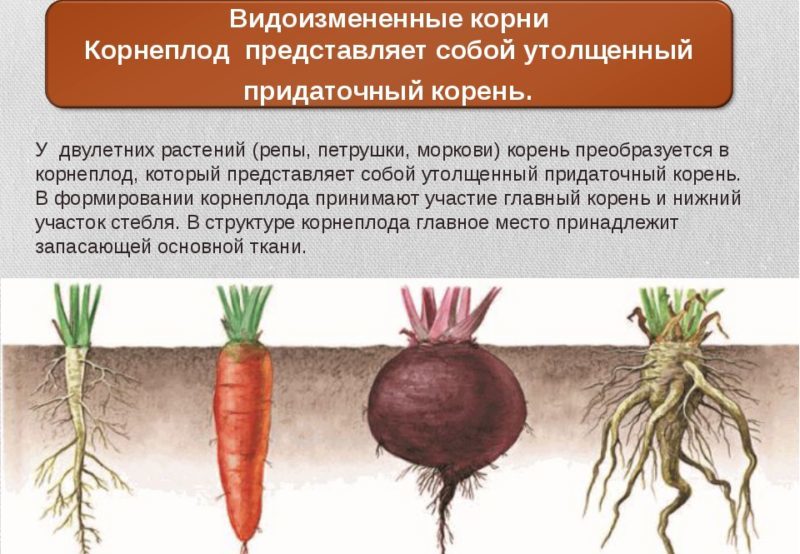
The root is thickened and fleshy. Usually oval, conical or cylindrical, up to 30 cm long and up to 5 cm in diameter.Depending on the varieties and growing conditions, the weight ranges from 100 to 300 g, the color varies from light yellow to red-violet, white and white-green are also found.
Varieties of red-orange root vegetables are the most valuable, as they contain a lot of carotene. Provitamin A improves vision, strengthens the immune system, and has antioxidant properties.
Structure
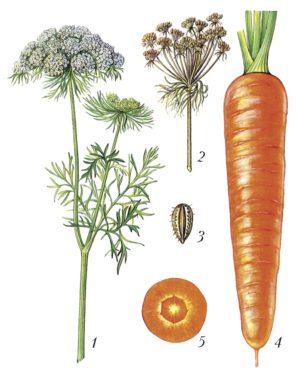
Carrots have a tap root system, where the main one stands out well among all the roots. It is converted into a root vegetable. There are additional lateral processes - short and weakly expressed, similar to thin hairs, arranged in 4 rows.
The roots go 1.5–2 m deep, the bulk of them are located at a distance of 25–30 cm from the surface of the earth. Thanks to such a powerful suction system, the carrots are saturated with oxygen and soil nutrients.
Root structure:
- Head (main shoot). It is a deformed shortened stem with internodes and axillary buds, on which the leafy part develops.
- Neck (subcotyledon). The upper part of the root crop, located above the soil. It has no leaves or roots.
- Main root. The lower part of the carrot, from which poorly developed roots extend.
Compound
The root vegetable consists of a core and bark, on the surface of which there are lentils (indentations). Air flows through them.
Between the inner and outer layers is the cambium layer, in which cells divide, causing carrots to grow. Thin lateral roots with many hair-like processes originate there.
Reference. Carrots are a rich source of carbohydrates, fiber, vitamins and minerals that are beneficial for the body. Therefore, it is used in many dishes and consumed in any form.
Functions
Main functions of the root system:
- Nourishes the plant. Root hairs absorb water from the soil with minerals dissolved in it.
- Maintains nutrient supply (starch, other carbohydrates). As a result, the main root thickens and turns into a root vegetable.
- Converts substances needed by the plant: reduces nitrates to nitrites, synthesizes some amino acids and alkaloids.
- Interacts with the roots of other plants, fungi, microorganisms living in the soil.
The reserve substances deposited in the root crop in the first year of life are spent on the development of flowering shoots, fruits and seeds in the next year.
What does a cross section of a root look like?
When examining cross sections, the root crop is treated with several solutions and examined under a microscope. However, even with the naked eye, two zones are visible in the cross-section:
- external (bark) - wide, orange, covered with thin skin;
- internal - (rod, wood), narrower, light yellow in color.
The main share of starch and fast carbohydrates is concentrated in the bark, so the pulp of the outer layer is tender and sweetish in taste.
The best varieties of carrots are those that have a thick bark and a small core., because the pulp is much more nutritious and tastier. The most valuable plants are those with a small core of the same color as the bark.
The thin skin allows moisture to easily penetrate inside. In dry weather without watering, the plant quickly dies as it is affected by fungal diseases. During a prolonged rainy period after a drought, the wood of root crops thickens and the bark cracks.
Favorable conditions for the development of the root system
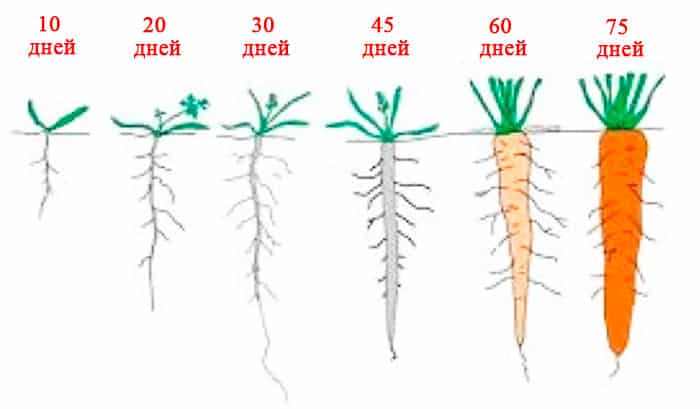
Carrots are a low-maintenance crop that grows under any circumstances. However, to obtain large, tasty and shelf-stable root vegetables rich in vitamins, it is important to create special conditions.
Temperature
Although carrots are classified as cold-resistant crops, their development occurs in a certain temperature regime:
- The minimum values for seed germination are +3…+6°С. The higher they are, the faster the seeds germinate.
- The optimal temperature for the formation and development of root crops is +18...+20°C.
- Vegetables grow until late autumn, when the air temperature no longer exceeds +8...+10°C.
Temperature changes negatively affect the entire plant. At low positive values, the color of the root becomes lighter. In dry, hot weather and lack of moisture in the soil, vegetables become coarse and deformed.
Light
Carrots are a light-loving crop and belong to long-day plants. With a short day, it grows more slowly, gains weight less well, and accumulates less nutrients, including carotene.
The density of crops and the presence of weeds significantly shade the plantings, as a result of which the harvest volume is reduced.
Humidity
The harvest takes a long time to form (4-5 months). During the growing season, the crop is demanding on the level of humidity, which is equally important at all stages of development, especially during seed germination and intensive root formation. Despite this, in wetlands, lowlands, and flooded areas in garden beds, carrots produce a poor harvest.
Important! With a lack of watering, the development of the root crop slows down, it becomes sluggish and bitter, it sends out lateral roots to seek moisture, which affects its appearance. If there is excess humidity, there is a risk that the carrots will crack.
In warm, dry weather, the bed is watered 3 times a week, in wet weather - 1 time. Young plants are not irrigated very much: 4 liters of water per 1 m² is enough. As you grow, the amount of liquid increases. The depth of moisture should correspond to the size of the root crops.
From mid-summer, the vegetable is watered once a week, using approximately 8–10 liters of water. 3 weeks before harvesting, irrigation is completely stopped.
The soil
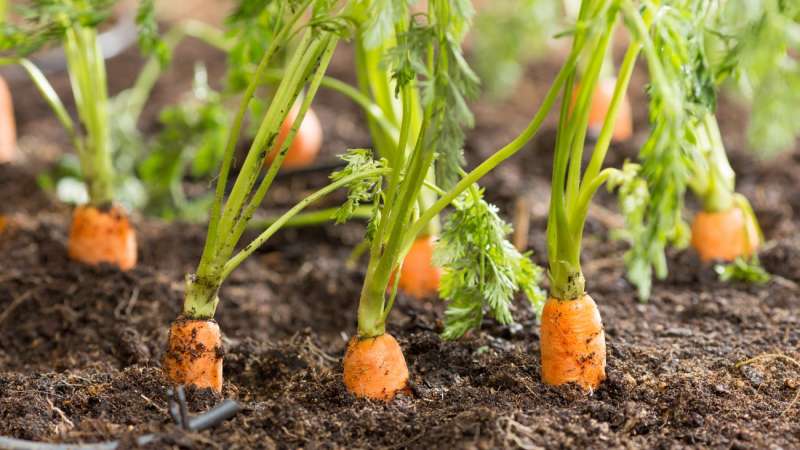
The crop is undemanding to the soil, but with the right soil composition, the yield increases significantly. Carrots are planted on slightly acidic or neutral soil. A suitable acidity indicator is 6-7 pH. The optimal humus content is from 4%.
Reference. If all agrotechnical conditions are met, the yield ranges from 500 to 700 c/ha.
The mechanical composition of the soil is important. Carrots prefer light and loose soil: sandy loam, loam or black soil with loosening additives. The optimal density is 0.65 g per 1 cm³. If necessary, the composition is improved with sand and old sawdust. In heavy clay soil, root vegetables grow small, deformed and tasteless.
Vegetable crops are selective towards their predecessors, among which the successful ones are considered tomatoes, pumpkin, onion, garlic, potato, salad.
Conclusion
In order to grow a decent harvest of smooth and sweet vegetables, it is important for gardeners to have basic knowledge about the structural features of the carrot root system, its functions, and favorable conditions for development. The crop is provided with good lighting, optimal temperature conditions, soil composition and timely sufficient watering.